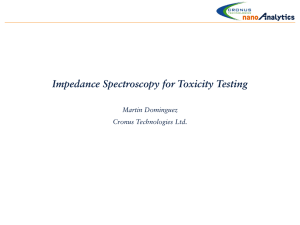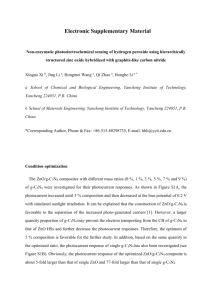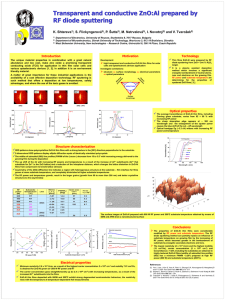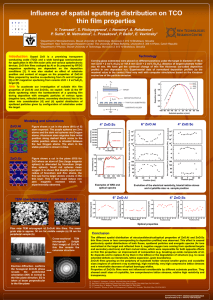Development of Uniformly Grown ZnO NPs films Using Single
advertisement
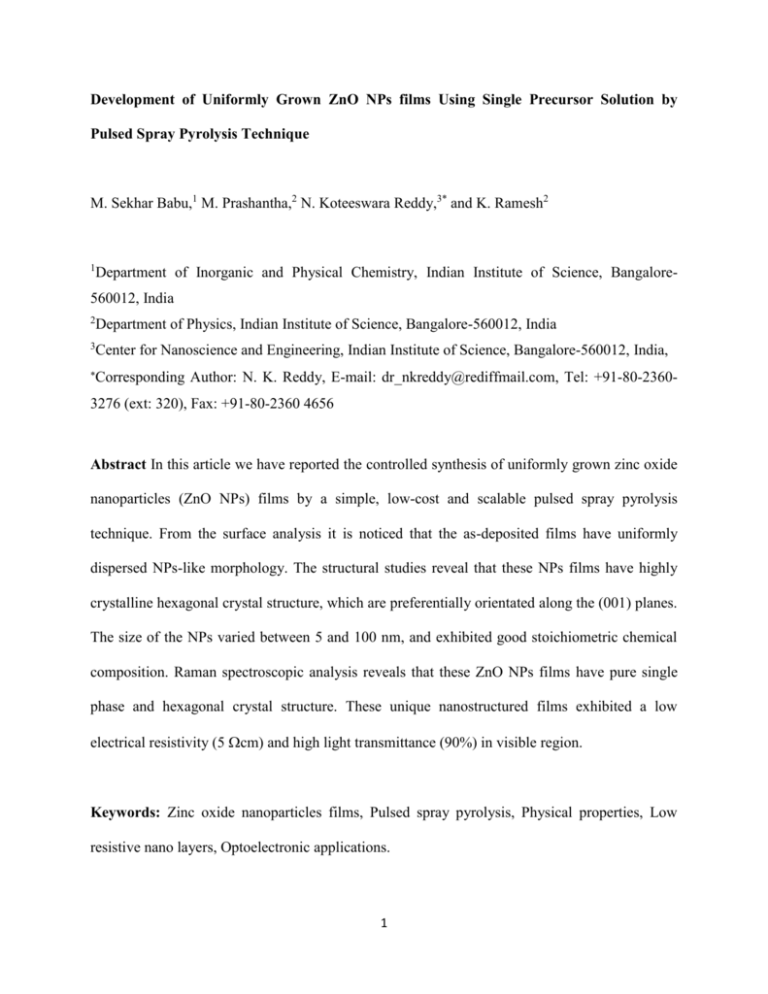
Development of Uniformly Grown ZnO NPs films Using Single Precursor Solution by Pulsed Spray Pyrolysis Technique M. Sekhar Babu,1 M. Prashantha,2 N. Koteeswara Reddy,3* and K. Ramesh2 1 Department of Inorganic and Physical Chemistry, Indian Institute of Science, Bangalore- 560012, India 2 Department of Physics, Indian Institute of Science, Bangalore-560012, India 3 Center for Nanoscience and Engineering, Indian Institute of Science, Bangalore-560012, India, Corresponding Author: N. K. Reddy, E-mail: dr_nkreddy@rediffmail.com, Tel: +91-80-2360- 3276 (ext: 320), Fax: +91-80-2360 4656 Abstract In this article we have reported the controlled synthesis of uniformly grown zinc oxide nanoparticles (ZnO NPs) films by a simple, low-cost and scalable pulsed spray pyrolysis technique. From the surface analysis it is noticed that the as-deposited films have uniformly dispersed NPs-like morphology. The structural studies reveal that these NPs films have highly crystalline hexagonal crystal structure, which are preferentially orientated along the (001) planes. The size of the NPs varied between 5 and 100 nm, and exhibited good stoichiometric chemical composition. Raman spectroscopic analysis reveals that these ZnO NPs films have pure single phase and hexagonal crystal structure. These unique nanostructured films exhibited a low electrical resistivity (5 cm) and high light transmittance (90%) in visible region. Keywords: Zinc oxide nanoparticles films, Pulsed spray pyrolysis, Physical properties, Low resistive nano layers, Optoelectronic applications. 1 Introduction Nanostructured materials have received incredible attention from the worldwide scientists due to their size-dependent electrical, mechanical and optical properties, which are unique as compared to their bulk counter-parts (Germeau et al. 2004). In this view, nanostructures of various materials have been realized using a variety of physical and chemical methods and studied their properties using advanced analytical techniques. However, there are two typical issues: i) the synthesis of high-quality nanostructured materials using either top-down or bottomup approach and ii) their adoption in the development of multifunctional devices, remaining yet as challenging tasks. Zinc oxide (ZnO), a II-VI group semiconductor material, has received significant attention in various fields due to its unique properties along with excellent bio-compatibility (Li et al. 2008). ZnO exhibits a wide band gap of 3.34 eV and high exciton binding energy (EBE) of 60 meV, which usually promotes ZnO as a candidate for the development of strong near band edge excitonic (NBE2) emitters even at higher temperatures since EBE of ZnO is nearly 2.5 times higher than that of room temperature (RT) thermal energy (kT~25 meV) (Ozgur et al. 2005). High transmittance in the visible region and good conductivity even at room temperature further promoted ZnO as a transparent electrode as well as conductive substrate for various optoelectronic devices (Haacke et al. 1977). ZnO is adopted as a window (electron-acceptor) material in the fabrication of inorganic as well as dye-sensitized solar cell devices (Zhang et al. 2009; Leschkies et al. 2009). Further, ZnO is also adopted as a sensor agent due to its sharp response for either reducing or oxidizing gases (Lee et al. 2009). In recent years, different types of ZnO nanostructures including nanoparticles (NP), nanorods (NR), nanotubes (NT), nanosheets (NS), nanoflowers (NF), nanocones (NC), 2 nanohierarchical (NH) and nanoboxes (NB) etc. have been synthesized using various methods including chemical solution, chemical vapor deposition, electrochemical deposition, etc. and studied their physical, chemical and mechanical properties (Wang et al. 2004). These nanostructures have also been utilized in the development of various prototype devices in order to realize their applicability and device performance. From the recent investigations, it can be clearly understood that the surface area of ZnO nanostructures has strong influence on the performance of the devices (Huang et al. 2007). In this view, ZnO NPs have advanced as an appropriate candidate for different applications including spintronics, sensors, bio-imaging, dyesensitized solar cells (DSSCs) etc. due to their large surface area and quantum confinement even at 10 nm sizes (Wang et al. 2010; Keis et al. 2002; Gabl et al. 2004). For example, Wang et al. developed ZnO/Au nanocomposite based surface-plasmon-resonance biosensors and observed good sensing response for bio-species. On the other hand, Keis et al. realized better light conversion efficiency of about 5% from ZnO NPs based DSSCs. Various methods have been used to synthesize uniformly dispersed ZnO NPs on specific substrates. However, till today there has been no reliable method proposed to grow monotonically dispersed high-quality ZnO NPs since a major constraint is the aggregation of NPs. Upon decreasing the size of NPs, their aggregation becomes dominant due to the formation of van der Waal forces between NPs (Kim et al. 2004; Shoyama et al. 2003). Usually, the aggregation of NPs lowers their surface-area and thereby, degrades the performance of the devices. It is, therefore, more crucial and vital to realize a method or approach for the development of uniformly grown ZnO NPs. In this connection, we developed a new approach for growth of high-quality ZnO NPs films with a good control over their growth as well as sizes by using pulsed spray pyrolysis technique. Here, the distance and angle between spray head and 3 substrates are noticed as crucial deposition parameters to control the quality and morphology of ZnO NPs films. In this article, we have reported the preliminary results including structural, composition, optical vibrational, electrical and optical properties of uniformly grown ZnO NPs films obtained from the above approach along with their growth mechanism. Experimental procedure Initially, we have designed an experimental setup by combining spray pyrolysis and atomic layer deposition concepts (see Supporting Information, SI-1 for schematic diagram of the setup) i.e. Pulsed Spray Pyrolysis method. Then, it has been adopted for the synthesis of highquality ZnO NPs films. The deposition were carried in open environment by spraying a single precursor solution of zinc nitrate (ZN, Zn(NO3)2). In a typical process, 5 mM solution was prepared by dissolving an appropriate amount of analytical grade ZN in deionized water (DIW) and sprayed onto the glass substrates kept at a substrate temperature (ST) of 40010 oC in pulse. Here, the average pulse length of sprayed solution was about ~1 s and the gap between the successive sprays was maintained as 10 s. Other deposition parameters such as solution flow rate (0.5 ml/s) and carrier gas flow rate (8 l/min with a pressure of ~ 1 bar) were kept constant. Further, the nozzle head to substrate angle and distance were also kept constant as 30 o and 50 cm, respectively. These parameters were roughly considered from our earlier studies (Reddy et al. 2007). The effective area of the deposition was around 2x2 cm2 and high pure nitrogen gas was used as carrier gas. Initially, the structures were prepared with three typical solution volumes of 50, 100, and 200 ml. The elemental composition and crystal structure of the as-deposited ZnO NPs films were studied using the energy dispersive analysis of X-rays (EDAX, Oxford Instruments) attached 4 with field emission scanning electron microscope (FESEM, ZEISS ULTRA 55, Gemini) and Xray Diffraction (XRD, Phillip’s XPERT PRO, PANalytical B.V., The Netherlands) with Cu Kα1 radiation (λ=0.1541 nm), respectively. The surface morphology of the NPs films was examined using FESEM, optical profilometer (Talysurf CCI Lite, Non-contact 3D Profiler) and atomic force microscope (AFM, Digital Instrument Nanoscope-E, Non-contact mode). The electrical and optical vibrational properties of the films were examined using probe-station attached with semiconductor parameter analyzer (Agilent Device Analyzer B1500A) and Raman spectrometer (LabRAM HR (HORIBA JOBINYUON)), respectively. The transmittance and band gap properties of as-deposited ZnO NPs films were studied using UV-Vis spectrophotometer (Perkin Elmer, Lambda 35) in the wavelength range of 300-1000 nm. Results and discussion FESEM analysis shows that the as-deposited ZnO films grown with 100 ml solution at a substrate temperature of 400 oC have uniform and well-covered NPs-like morphology with a smooth surface (Fig. 1b). These NPs are densely packed together and monotonically grown on the entire substrate (SI-2a). Moreover, these NPs have different sizes and their surface diameter (found from FESEM) varied between 10 and 90 nm. The thickness of the films, estimated based on the step formed between the substrate and film by optical-profilometer, is found to be 30 nm (see SI-2b) and rms surface roughness of the films estimated by both optical-profilometer as well as AFM methods, is found to be 5.17 nm (see SI-2c). On the other hand, the ZnO NPs films grown with other quantities of solution exhibited quite different surface morphologies, which can be seen from Fig.1. The ZnO NPs films grown with lower volumes of solution have intermittent surface with deeper voids (Fig. 1a), whereas the films prepared with higher volumes have 5 densely packed microcrystals that are composed of fine tiny NPs (see SI-1b). In view of our major goal, further studies have been carried out exclusively on the ZnO NPs films grown with 100 ml solution at ST=400 oC. XRD profile (Fig. 2a) of ZnO NPs films exhibited six identifiable diffraction peaks at 231.85, 34.38, 36.22, 47.59, 56.52, and 62.81o. Among them, the peak diffracted at 34.38o is dominant. The evaluated inter-planar atomic spacing (d-spacing) values of these peaks exactly match with the hexagonal bulk ZnO data (JCPDS), which implies that the diffracted peaks belong to (100), (002), (101), (102), (110), and (103) planes, respectively. It also shows that most of the ZnO NPs films grown on glass substrate are preferentially oriented along the (002) plane, i.e. c-direction. Further, the lattice parameters (a, c) of these hexagonal ZnO NPs films are found to be 0.326 and 0.521 nm, respectively, which are comparable with the bulk ZnO (SI-3a) data. As compared to earlier reports on ZnO NPs structures, these ZnO NPs films are quite peculiar and also interesting (Pandey et al. 2010; Lo et al. 2010; Zak et al. 2011; Turner et al. 2010; Chen et al. 2008). For example, the ZnO NPs grown by various methods have contained dominant multiple facets and have (101) orientation as predominant plane. The evaluated full width at half maximum (FWHM) values for all diffracted peaks (see SI-3b) reveal that the average size of crystallites oriented along the (102) plane is low (~22 nm), whereas it is high (~98 nm) for the crystallites oriented along (101) plane. On the other hand, the lattice-strain between the (102) crystallites is high (0.46 %) as compared to the crystallites (0.19%) oriented along (101) planes (see SI-3c). The theoretically calculated crystallite sizes are nearly comparable with the experimental data observed in FESEM analysis. These results, therefore, reveal that the as-deposited ZnO NPs films by PSP method have pure hexagonal ZnO phase. Further, the chemical purity of ZnO NPs films was examined by EDAX attached to 6 FESEM (see Fig. 2b) and noticed good stoichiometry between its constituent elements since Zn/O ratio is found to be ~1.02 (Zn=50.99 and O=49.01 at.%). The micro Raman spectrum of ZnO NPs films recorded between 200 and 1500 cm-1 using a 514 nm laser source with a power of 5 mW is shown in Fig. 3a. Based on the group theory, the wurtzite structured ZnO belongs to C 6v4 space group and consists of two formula units per primitive cell. Among its optical phonon modes, the non polar modes (E2L and E2H) and polar modes (A1 (LO), A1 (TO) and E1 (TO)), where, E2L and E2H are a low and high frequency E2 modes, LO-longitudinal and TO-transverse optical phonon modes, are Raman active. Further, it is well known that the E2H and E2L vibrational modes are associated to oxygen atoms and heavy zinc sublattice, respectively. The as-deposited ZnO NPs films on glass substrate exhibited three clearly distinguishable Raman peaks centered at 560±5, 780±5 and 1095±5 cm-1 along with three weak peaks at 350±5, 455±5 and 950±5 cm-1. As-compared to bulk ZnO (ZnOb) (Ozgur et al. 2005), the observed Raman peaks at lower frequencies (<550 cm-1) have slight blue shift (BS) in their positions, which is probably attributed to surface and size effects of NPs (Wesselinowa et al. 2010; Alim et al. 2005). The first peak observed at 350 cm-1 with BS of 7 cm-1 (ZnOb = 343 cm-1) is a nonpolar phonon mode and belongs to second-order undertone (i.e. E2H-E2L) vibrations, which originates from the disorder ZnO NPs (Mead et al. 1977). The second peak noticed at 455 cm-1 has a BS of about 10 cm-1 (ZnOb = 444 cm-1) that corresponds to the vibration mode of E2H (Ozgur et al. 2005). From these results, the probable position of E2L peak is found to be 105 cm-1, which also has a BS of about 4 cm-1 since ZnOb=101 cm-1. Based on the previous reports and present results we have emphasized that the as-deposited ZnO NPs films on glass substrates have considerable longitudinal stress (Lo et al. 2010; Cong et al. 2005). 7 On the other hand, the peaks observed at higher wave frequencies ( >550 cm-1, i.e. 565, 780, 950 and 1095 cm-1) have slight red shift (RS) in their position, which is mainly attributed to the presence of strain- induced structural defects in the as-deposited NPs films (Alim et al. 2005). However, among the other peaks, the peak observed at 565 cm-1 (RS of about 14 cm-1 since ZnOb=579 cm-1) is dominant and belongs to polar A1 (LO) phonon mode (Lo et al. 2010). It clearly emphasizes that the as-deposited ZnO NPs films have strong polar lattice bonds. Further, the absence of E1 (LO) peak probably at around 590 cm-1 and presence of A1 modes reveal that the as-deposited NPs films probably consists: i) the lattice vibrations parallel to their growth direction, ii) Zn-terminated surface, and iii) good in quality and phase purity (Ozgur et al. 2005). Noticeably Alim et al. also observed similar peak at 565 cm-1 from the Raman spectrum of chemically produced ZnO NPs exclusively with 325 nm laser light (Alim et al. 2005). While increasing the power of the laser from 2 to 20 mW they observed small RS in the position of A 1 (LO) peak. This RS has been assigned to the local heating of nanostructures when the ZnO NPs were illuminated with UV laser. In the present study, contrary to the above results, we have observed same A1 (LO) peak with the same 514 nm laser light at 5 mW power. Further, while increasing the power of the light source from 5 to 20 mW (Fig. 3b) as well as acquisition time from 5 to 20 s (SI-4a) we could not notice any change in the position of Raman peaks. Thus, the presence of A1 (LO) peak with considerable RS in ZnO NPs films is due to the strain formed between NPs or interstitial defects (Ayouchi et al. 2003). Here, the other peaks observed at higher frequencies, i.e. 780, 950 and 1095 cm-1 can be attributed to second-order multiple phonons scattering process (overtones). These multiple phone peaks probably correspond to 2E2H-E2L, 2E2H+E2L and 2A1 (LO) with RS of 7, 30, 35 cm-1, respectively. Sato-Berru et al. (Sato-Berru et al. 2007) also observed similar 2A1 (LO) peak from 8 the Raman spectrum of ZnO NPs grown by chemical precipitation method. As compared to the bulk material, considerable RS in LO phonon-frequencies strongly reveal the presence of point defects in the as-deposited ZnO NPs films (Ozgur et al. 2005). However, the presence of A1 (LO) and E2 vibrational modes as active and absence of other modes as forbidden reveal that most of the ZnO NPs deposited with PSP method are highly oriented along the (002) planes, which is in accordance with the results observed in XRD studies. The FWHM of A1 (LO) and 2A1 (LO) peaks is found to be 69 (8.6 meV) and 97 (12.04 meV) cm-1, respectively. The intensity ratio of A1 (LO) and 2A1 (LO) peaks (i.e. I2A1/IA1) is about 1.63 (see SI-4b), which is lower than that of its bulk (2.01) (Scott et al. 1970). Cheng et al. (Cheng et al. 2005) also noticed two different values for A1 (LO) and 2A1 (LO) peaks with their intensity ratio of 0.56. Further, they have also observed a gradual increase in FWHM values and decrease in I2A1/IA1 ratio with the decrease of NPs size. However, from the Raman spectra of the present ZnO NPs films recorded with a power of 20 mW, we noticed nearly the same FWHM values for both the A1 (LO) peaks as 100 cm-1 (12.4 meV) (see SI-4c). Based on these results it can be understood that the FWHM values of the Raman peaks are dependent not only on the quality of the material but also on power of the excitation light. Further, I2A1/IA1 ratio of the ZnO NPs films is strongly attributed to the size of the particles. In order to confirm the presence of Zn-terminated surface we studied the electrical behavior of as-deposited ZnO NPs films at different temperatures (see SI-5) since, in general, Zn-terminated nanostructures or films exhibit positive temperature coefficient (Koteeswara Reddy et al. 2008) i.e. metallic behavior due to the formation of shunt-resistors between Zn and metallic atoms. The measured current-voltage (I-V) plots by two-probe method at different temperatures are shown in Fig. 4a. It shows that the as-deposited ZnO NPs films have just 9 semiconductor like behavior since the slope of the I-V plots gradually increased with the increase of temperature. Therefore, it can be confirmed that the as-deposited ZnO NPs films may not contain Zn-terminated surface. Further, the linear trend in I-V plots strongly demonstrates that at all temperatures the deposited contacts have good Ohmic relation with as-deposited ZnO NPs films. At room temperature, the resistivity of ZnO NPs films with contacts is found to be 5 cm, whereas without contacts, it is slightly high (14 cm) but considerably impressive. Thus, the asdeposited ZnO NPs films are good electrical conductors since it is comparable with transparent conducive oxide films. The variation of normalized resistance (ln(R/Ro)) with inverse temperature (1/T) is shown in Fig. 4b. While increasing temperature, these films exhibited two distinguishable activation energies (AE, evaluated from Arrhenius equation) of about 0.11 and 0.23 eV along with a flat region AE of 4 meV. These AE values are probably originated from the conduction of carriers between donor impurities and conduction band. On the other hand, the thermal conducting behavior of ZnO NPs films is slightly different than that of its bulk and thus, it requires more studies to understand this peculiar behavior of ZnO NPs films. From these investigations it can be emphasized that these unique and low resistive ZnO nanostructured films developed by PSP method could be directly adopted in the development of various optoelectronic devices. The transmittance versus wavelength spectrum of ZnO NPs films is shown in Fig. 5. At higher wavelengths (>400 nm) these nanostructures exhibited a high transmittance of ~90%. A sharp rise in the transmittance of light with a small change of wavelength clearly reveals that the carrier transition between the top of the valance band and the bottom of the conduction band is direct. Therefore, the direct energy band gap of the structures was obtained from (h)2 versus the photon energy (h) plot by extrapolating its linear part to (h)2 =0 (see Fig. 5). The direct 10 optical band gap (Eg) of the structures is found to be ~3.44 eV. This value is slightly higher than that of its bulk (~3.3 eV) (Pearton et al. 2005), which could be attributed to two factors: i) presence of quantum confined NPs (see SI-6) and ii) existence of longitudinal stress. In order to develop highly conductive and transparent nanostructured TCO layers, we shed the light on doping of ZnO NPs films with appropriate donor impurities and/or annealing of ZnO NPs films under oxygen ambient, as a next step. Growth mechanism The growth mechanism of ZnO NPs films and thereby uniform growth nanostructures has been described by a simple three-stage process, which is presented as a schematic diagram in Fig. 6. Initially, upon dissolving ZN in DIW it dissociates into Zn2+ and ( NO3 ) (Xu at al. 2011; Hassan et al. 2012). H 2O Zn( NO3 ) 2 Zn 2 2( NO3 ) . As per the earlier observations (Studenikin et al. 1998), upon spraying, the sprayed droplet(s) undergoes pyrolytic decomposition on the surface of hot substrate and forms ZnO nuclei through different intermediate products. The possible chemical reaction(s) on the hot substrate are as follows: Zn 2 Zn(OH ) 2 o C NO3 H 2O Zn2O( NO3 ) 2 T xZnO yN m On zO2 Zn(OH )( NO ) 3 T oC The formed ZnO nuclei act as the building block for the formation of the final products. In stage II, the ZnO nanocrystallites form through the nucleation of ZnO nuclei, which were generated from the continuous spraying of solution. Finally, the growth of uniformly dispersed ZnO 11 nanocrystalline particles films will takes place through the coalescence of adjacent ZnO NPs at stage III. Upon prolonging the spray process in pulse, the growth of NPs takes place through the elongation of nanocrystallites. The volatile byproducts evolved at all stages escape in the form of vapors. Here, the heated substrate provides an appropriate thermal energy necessary for the decomposition of chemical species and subsequent nucleation of atoms and molecules. The growth rate of ZnO NP in a certain direction and their shapes are governed by the surface energy of the lattice planes (Wang et al. 2000). In general, the lattice planes with lower surface energy tend to dominate over the others and the final shape of the crystals is decided by the competitive growth of a crystal along different directions. Conclusions Uniformly grown ZnO NPs films have been prepared on glass substrates using pulsed spray pyrolysis method at a substrate temperature of 400 oC. From the structural, electrical and optical investigations the following conclusions are drawn on as-deposited ZnO NPs films. The as-deposited ZnO NPs films are highly crystalline and have uniform surface with rms roughness of 5 nm. These NPs films are preferentially oriented along the <001> direction and their particle sizes varied between 5 and 100 nm. Further, these nanostructures have good quality and also have chemical stoichiometry between its constituents. The ZnO NPs films are good conductors and highly transparent in visible region. These ZnO nanostructured films exhibited slightly higher optical band gap (3.44 eV) than that of its bulk. Therefore, these asdeposited ZnO NPs films are unique and can be adopted in the development of various devices including dye-sensitized solar cell cells, chemical sensors, dilute magnetic semiconductors with appropriate dopants and biological devices. 12 Acknowledgements Dr N. K. Reddy, wish to acknowledge the CSIR for the sanction of SRA fellowship under the scheme of Scientist’s pool (A-8525). Further, all the authors are highly acknowledging the support of MNCF staff, IISc, Bangalore in the characterization of these structures. References Alim KA, Fonoberov VA, Shamsa M, Balandin AA (2005) Micro-Raman investigation of optical phonons in ZnO nanocrystals. J Appl Phys 97(12): 124313-124317. Ayouchi R, Leinen D, Martin F, Gabas M, Dalchiele E, Ramos-Barrado JR (2003) Preparation and characterization of transparent ZnO thin films obtained by spray pyrolysis. Thin Solid Films 426(1-2):68-77. Chen TH, Fang FY, Hung LW, Ji SJ, Chang SJ, Young, Hsiao YJ (2008) The crystallization and physical properties of Al-doped ZnO nanoparticles. Appl Surf Sci 254 (18):5791-5795. Cheng HM, Lin KF, Hsu HC, Lin CJ, Lin LJ, Hsieh WF (2005) Enhanced Resonant Raman Scattering and Electron−Phonon Coupling from Self-Assembled Secondary ZnO Nanoparticles. J Phys Chem B 109(39):18385-18390. Cong GW, Wei HY, Zhang PF, Peng WQ, Wu JJ, Liu XL, Jiao CM, Hu WG, Zhu QS Wang ZG (2005) One-step growth of ZnO from film to vertically well-aligned nanorods and the morphology-dependent Raman scattering. Appl Phys Lett 87(23):231903-231905. Gabl R, Feucht HD, Zeininger H, Eckstein G, Schreiter M, Primig R, Pitzer D, Wersing W (2004) First results on label-free detection of DNA and protein molecules using a novel integrated sensor technology based on gravimetric detection principles. Biosens Bioelectron 19(6):615-620. 13 Germeau A, Roest AL, Vanmaekelbergh D, Allan G, Delerue C, Meulenkamp EA (2003) Optical Transitions in Artificial Few-Electron Atoms Strongly Confined inside ZnO Nanocrystals. Phys Rev Lett 90(9):097401-097404. Guillen E, Azaceta E, Peter LM, Zukal A, Tena-Zaera R, Anta JA (2011) ZnO solar cells with an indoline sensitizer: a comparison between nanoparticulate films and electrodeposited nanowire arrays. Energy Environ Sci 4:3400- 3407. Haacke (1977) Transparent Conducting Coatings. Annu Rev Mater Sci 7:73-93. Hassan NK, Hashim MR, Al-Douri Y, Al-Heuseen K (2012) Current Dependence Growth of ZnO Nanostructures by Electrochemical Deposition Technique. Int J Electrochem Sci 7:4625-4635. Huang XJ, Choi YK (2007) Chemical sensors based on nanostructured materials. Sens Actuators B 122(2):659- 671. JCPDS data of bulk ZnO: 36-1451. Keis K, Magnusson E, Lindstrom H, Lindquist SE, Hagfeldt A (2002) A 5% efficient photoelectrochemical solar cell based on nanostructured ZnO electrodes. Sol Energy Mater Sol Cells 73(1):51-58. Koteeswara Reddy N, Ramakrishna Reddy KT (2007) Preparation and characterisation of sprayed tin sulphide films grown at different precursor concentrations. Mater Chem Phys 102:13–18. Koteeswara Reddy N, Ahsanulhaq Q, Kim JH, Hahn YB (2008) Well-aligned ZnO nanorods for device applications: Synthesis and characterisation of ZnO nanorods and n-ZnO/p-Si heterojunction diodes. EPL 81:38001-1p-p6. Min, BK, Choi SD (2004) Sens. Actuators B 98(2-3):239-246. 14 Lee JH (2009) Gas sensors using hierarchical and hollow oxide nanostructures: Overview. Sens Actuators B 140(1):319-336. Leschkies KS, Beatty TJ, Kang MS, Norris DJ, Aydil ES (2009) Solar Cells Based on Junctions between Colloidal PbSe Nanocrystals and Thin ZnO Films. ACS Nano 3(11):3638- 3648. Li Z, Yang R, Yu M, Bai F, Li C, Wang ZL (2008) Cellular Level Biocompatibility and Biosafety of ZnO Nanowires. J Phys Chem C 112(51):20114- 20117. Liu Y, Dong J, Liu M (2004) Well-Aligned “Nano-Box-Beams” of SnO2. Adv Mater 16(4):353356. Lo SS, Huang D (2010) Morphological Variation and Raman Spectroscopy of ZnO Hollow Microspheres Prepared by a Chemical Colloidal Process. Langmuir 26(9):6762- 6766. Mead DG, Wilkinson GR (1977) The temperature dependence of the Raman effect in some wurtzite type crystals. J Raman Spectroscopy 6(3):123-129. Ozgur U, Alivov YI, Liu C, Teke A, Reshchikov MA, Dogan S, Avrutin V, Cho SJ, Morkoc H (2005) A comprehensive review of ZnO materials and devices. J Appl Phys 98(4):041301041404. Pandey, Sanjay SS, Yadav RS (2010) Application of ZnO nanoparticles in influencing the growth rate of Cicer arietinum. J Exp Nanoscience 5(6):488-497. Pearton SJ, Norton DP, Ip K, Heo YW, Steiner T (2005) Recent progress in processing and properties of ZnO Prog Mater Sci 50(3):293-340. Sato-Berru RY, Vazquez-Olmos A, Fernandez-Osorio AL, Sotres-Martinez S (2007) MicroRaman investigation of transition-metal-doped ZnO nanoparticles. J Raman Spectroscopy 38(9):1073-1076. Scott JF (1970) uv Resonant Raman Scattering in ZnO. Phys Rev B 2(4):1209-1211. 15 Shoyama M, Hashimoto N (2003) Effect of poly ethylene glycol addition on the microstructure and sensor characteristics of SnO2 thin films prepared by sol–gel method, Sens Actuators B 93(1-3):585-589. Studenikin SA, Golego N, Cocivera M (1998) Optical and electrical properties of undoped ZnO films grown by spray pyrolysis of zinc nitrate solution 83(4):2104-2111. Turner S, Tavernier SMF, Huyberechts G, Biermans E, Bals S, Batenburg KJ, Van Tendeloo G (2010) Assisted spray pyrolysis production and characterisation of ZnO nanoparticles with narrow size distribution. J Nanopart Res 12(2):615-622. Wang ZL (2004) Zinc oxide nanostructures: growth, properties and applications. J Phys Condens Matter 16(25):R829-R858. Wang L, Sun Y, Wang J, Wang J, Yu A, Zhang H, Song D (2010) Water-soluble ZnO–Au nanocomposite-based probe for enhanced protein detection in a SPR biosensor system. J Coll Interf Sci 351(2):392-397. Wang ZL (2000) Transmission Electron Microscopy of Shape-Controlled Nanocrystals and Their Assemblies. J Phys Chem B 104(6):1153-1175. Wesselinowa JM, Apostolov AT (2010) Origin of the acoustic phonon frequency shifts in semiconducting nanoparticles. Phys Lett A 374(43):4455-4457. Xu S and Wang ZL (2011) One-Dimensional ZnO Nanostructures: Solution Growth and Functional Properties. Nano Res DOI 10.1007/s12274-011-0160-7 Zak AK, Razali R, Majid WHA, Darroudi M (2011) Synthesis and characterization of a narrow size distribution of zinc oxide nanoparticles. Int J Nanomedicine 6:1399-1403. 16 Zhang Q, Dandeneau CS, Zhou X, Cao G (2009) ZnO Nanostructures for Dye-Sensitized Solar Cells. Adv Mater 21(41):4087-4108. Figure captions: Figure 1: High magnification FESEM images of ZnO NPs films deposited on glass substrate with different volumes of (a) 50, (b) 100 (inset shows its AFM image) and (c) 200 ml solution at ST= 400 oC. Figure 2: (a) XRD profile of ZnO NPs film deposited with 100 ml solution at ST= 400 oC and (b) its EDAX profile. Figure 3: Raman spectrum of ZnO NPs film deposited with 100 ml solution at ST= 400 oC recorded with (a) 5 mW power and (b) at different powers. Figure 4: (a) I-V plots of ZnO NPs films deposited with 100 ml solution at ST= 400 oC and, which were measured at different temperatures and (b) ln(R/Ro) versus 1000/T plot of ZnO NPs films (AE-activation energy calculated using the Arrhenius equation). Figure 5: T% versus wavelength and photon energy versus (h)2 plots of ZnO NPs film deposited with 100 ml solution at ST= 400 oC. Figure 6: A Schematic diagram of formation of ZnO NPs film in pulsed spray pyrolysis method. Here, after spray (I) formation of ZnO nuclei through decomposition of sprayed droplets, (II) formation ZnO NP through nucleation of ZnO nuclei, (III) formation of NPs film through coalescence at higher substrate temperatures. 17
